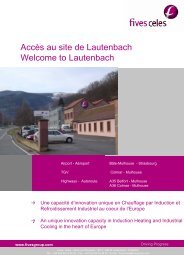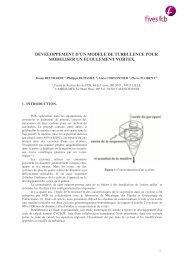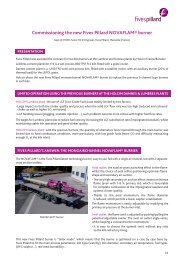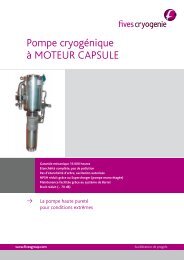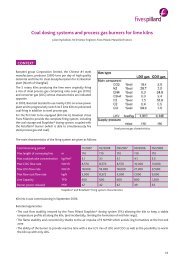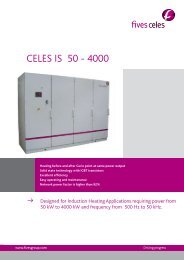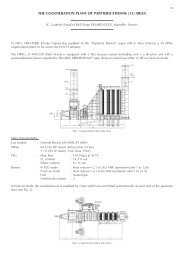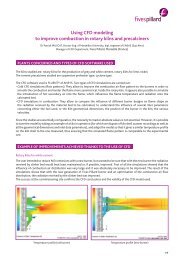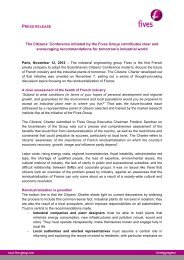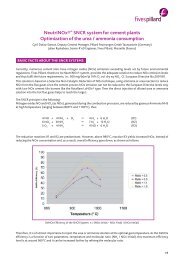Burners for white cement kilns: Calcia Cruas (France) - Fives
Burners for white cement kilns: Calcia Cruas (France) - Fives
Burners for white cement kilns: Calcia Cruas (France) - Fives
You also want an ePaper? Increase the reach of your titles
YUMPU automatically turns print PDFs into web optimized ePapers that Google loves.
PRESENTATION<br />
<strong>Burners</strong> <strong>for</strong> <strong>white</strong> <strong>cement</strong> <strong>kilns</strong>: <strong>Calcia</strong> <strong>Cruas</strong> (<strong>France</strong>)<br />
Gaël LE PIVER, Senior Rn’D Engineer, <strong>Fives</strong> Pillard, Marseille (<strong>France</strong>)<br />
For the manufacture of <strong>white</strong> <strong>cement</strong>, the burning process is subject<br />
to special requirements and the burner design must take into account<br />
certain criteria:<br />
Even with a very low secondary air temperature, <strong>white</strong> <strong>cement</strong><br />
manufacture requires a higher sintering temperature (hot and short<br />
flame).<br />
Clinker quenching is of main importance so as to avoid any clinker<br />
oxidation ( coloured oxides).<br />
The coating is thin and specific care must be taken to avoid any flame<br />
impingement.<br />
To complicate matters, each plant is different: secondary air temperature & windbox design, cooling technology, water<br />
injection… which requires in each case a “tailor made” burner and, if necessary, a CFD study - <strong>for</strong> example to improve the<br />
secondary air distribution and velocity around the burner.<br />
SITE RESULTS<br />
White <strong>cement</strong> burner<br />
Kiln model<br />
White <strong>cement</strong> structure<br />
<strong>Cruas</strong> plant is a 600 tpd <strong>white</strong> <strong>cement</strong> kiln in southern <strong>France</strong>. <strong>Calcia</strong> was<br />
faced with problems using their existing 3-channel burner when firing a<br />
mixture of petcoke, high viscosity oil and waste oil. The flame shape was<br />
to be improved with petcoke over 30% thermal load. Moreover, NOx<br />
emissions were high (over 1,100 mg/Nm 3 @ 10 % O 2 ), leading to a high<br />
urea consumption. The existing burner was operating with high primary air<br />
(17% of total combustion air), which was unfavourable <strong>for</strong> the specific heat<br />
consumption.<br />
As a first step, <strong>Fives</strong> Pillard made a CFD study thanks to Fluent® software<br />
and modelled the kiln and secondary air inlet in order to analyse the pathflow<br />
& combustion with the previous burner.<br />
1/2
Once the weaknesses of the existing installation were identified (recirculation zone, uneven secondary air spread), various<br />
design parameters were tested with the numerical model (secondary air windbox velocity, burner swirl…), in order to obtain<br />
a more concentric & radiating flame.<br />
The ROTAFLAM® Version 2 (RV2) was commissioned in April 2008. After 1 year of operation, <strong>Calcia</strong> CRUAS is satisfied:<br />
Thanks to the concentric flame, a stable kiln operation is now possible even with pure petcoke firing.<br />
Even with a lower primary air flow (12% of combustion air), the flame is stronger, allowing easier clinker cooking and<br />
maintaining a high level of clinker <strong>white</strong>ness without any flame impingement on the bricks.<br />
The NOx was reduced from 1,100 to 800 mg/Nm3 @10 %O , almost without any further need of urea.<br />
2<br />
The burner flexibility allows smoother operation, especially during fuel switch-over. Consequently, the kiln availability is<br />
higher, and the process more stable.<br />
CONCLUSION<br />
COLD HOT<br />
Flame temperature profile<br />
with the 3 channel burner<br />
Flame temperature comparison<br />
Weaknesses of the existing installation<br />
Radiating flux with the new burner<br />
Flame temperature profile<br />
with the ROTAFLAM® Radiating flux with the previous burner<br />
The site results confirm that the help of CFD can be a decisive factor in choosing the best design parameters, particularly<br />
in the case of a special process. Thanks to the new burner & secondary air windbox, the direct benefit <strong>for</strong> the CRUAS plant<br />
is higher fuel mastery (easier to fire 100% petcoke), an easier and more stable kiln operation and a significant reduction in<br />
the consumption of urea.<br />
2/2



